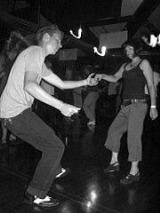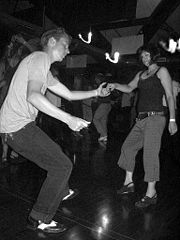
Mura Dehn
Encyclopedia
Mura Dehn documented African-American social jazz dancing at the Savoy Ballroom
in New York between 1920 and 1940, a time that she referred to as the "Golden Age of Jazz." She also worked as a producer and documenter up until her death, and was co-artistic director of Traditional Jazz Dance Theater, along with vaudeville performer James Berry.
Dehn was raised in Russia
where she was schooled in ballet
and modern dance by Ellen Tels, a student of Isadora Duncan. She realized early on that dance would be her passion in life. During her training she was exposed to many styles of dance, including jazz. However, she did not become interested in the style of jazz dance until later.
In 1925 Dehn ventured to Paris
in hopes of furthering her dance career. There, she saw Josephine Baker
perform. At that time in Paris, Baker was regarded as one of the best jazz dancers in the country, and was extremely popular. Mura Dehn then realized that she was very attracted to jazz dance. She instantly became a fan and decided to take up jazz dance to see where it would lead her.
 By 1930 Mura Dehn had immigrated to New York
By 1930 Mura Dehn had immigrated to New York
. One night in New York Dehn stumbled across the Savoy Ballroom. Inside, she witnessed dancing that was completely foreign to her and she loved it. She took it upon herself to somehow document what she saw for later generations. The best way that she could think of was to put it on film.
This process was a long and hard one that took many, many years but she believed it had to be done. She also believed that African-Americans, through authentic jazz dancers, changed the way the world experienced rhythm and viewed the dancing body. In the end she created two films: The Spirit Moves
and In A Jazz Way.
The Spirit Moves: A History of Black Social Dance on Film, 1900-1986 is her five-hour documentary about the evolution of black dance in urban America in the early 1900s-to the mid-Eighties. The film is a unique visual record of vernacular jazz dancing that celebrated the heritage of movement that shaped the way we dance, on and off stage.
In a Jazz Way: A Portrait of Mura Dehn" is a short biographical film created about Mura Dehn, including some of her work with the Savoy Ballroom dancers as well as with hip-hop artists in the 1980s.
Savoy Ballroom
The Savoy Ballroom, located in Harlem, New York City, was a medium sized ballroom for music and public dancing that was in operation from March 12, 1926 to July 10, 1958. It was located between 140th and 141st Streets on Lenox Avenue....
in New York between 1920 and 1940, a time that she referred to as the "Golden Age of Jazz." She also worked as a producer and documenter up until her death, and was co-artistic director of Traditional Jazz Dance Theater, along with vaudeville performer James Berry.
Dehn was raised in Russia
Russia
Russia or , officially known as both Russia and the Russian Federation , is a country in northern Eurasia. It is a federal semi-presidential republic, comprising 83 federal subjects...
where she was schooled in ballet
Ballet
Ballet is a type of performance dance, that originated in the Italian Renaissance courts of the 15th century, and which was further developed in France and Russia as a concert dance form. The early portions preceded the invention of the proscenium stage and were presented in large chambers with...
and modern dance by Ellen Tels, a student of Isadora Duncan. She realized early on that dance would be her passion in life. During her training she was exposed to many styles of dance, including jazz. However, she did not become interested in the style of jazz dance until later.
In 1925 Dehn ventured to Paris
Paris
Paris is the capital and largest city in France, situated on the river Seine, in northern France, at the heart of the Île-de-France region...
in hopes of furthering her dance career. There, she saw Josephine Baker
Josephine Baker
Josephine Baker was an American dancer, singer, and actress who found fame in her adopted homeland of France. She was given such nicknames as the "Bronze Venus", the "Black Pearl", and the "Créole Goddess"....
perform. At that time in Paris, Baker was regarded as one of the best jazz dancers in the country, and was extremely popular. Mura Dehn then realized that she was very attracted to jazz dance. She instantly became a fan and decided to take up jazz dance to see where it would lead her.

New York
New York is a state in the Northeastern region of the United States. It is the nation's third most populous state. New York is bordered by New Jersey and Pennsylvania to the south, and by Connecticut, Massachusetts and Vermont to the east...
. One night in New York Dehn stumbled across the Savoy Ballroom. Inside, she witnessed dancing that was completely foreign to her and she loved it. She took it upon herself to somehow document what she saw for later generations. The best way that she could think of was to put it on film.
This process was a long and hard one that took many, many years but she believed it had to be done. She also believed that African-Americans, through authentic jazz dancers, changed the way the world experienced rhythm and viewed the dancing body. In the end she created two films: The Spirit Moves
The Spirit Moves
-External links:**...
and In A Jazz Way.
The Spirit Moves: A History of Black Social Dance on Film, 1900-1986 is her five-hour documentary about the evolution of black dance in urban America in the early 1900s-to the mid-Eighties. The film is a unique visual record of vernacular jazz dancing that celebrated the heritage of movement that shaped the way we dance, on and off stage.
In a Jazz Way: A Portrait of Mura Dehn" is a short biographical film created about Mura Dehn, including some of her work with the Savoy Ballroom dancers as well as with hip-hop artists in the 1980s.
Sources
- Sommer S., 2001, "Heaven at The Savoy"
- Dunning J., 1987, New York Times "Mura Dehn, Dancer, As Subect and Chronicler",
- Stine S., 1998, The Savoy Ballroom

